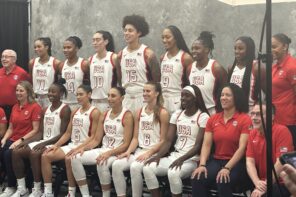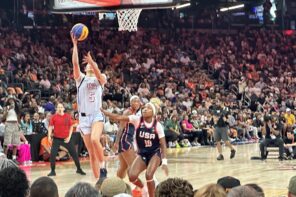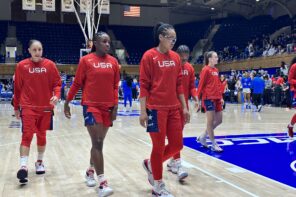Collegiate athletics realignment – it appears to be all the rage in the realm of college sports these days.
At this point, collegiate athletics – particularly the cash cows of basketball and football – are so flush with money coming from television conglomerates such as ESPN, Fox, NBC and CBS that tradition and regional rivalries are merely public relations points. We are even seeing conferences do deals with streaming outlets.
One of those is Apple – and it has been an entity that has been H&H recently with the Pac-12.
The Pac-12 is a conference that appears to be on life support. It all began when USC and UCLA, the two flagship schools in the Los Angeles media market, announced that they would be jumping ship to the Big Ten.
Of course, from a traditional or a regional standpoint, going to the Big Ten – whose nucleus is in the Midwest and whose headquarters is in Chicago – makes close to zero sense for two schools who play in the Pacific Time Zone.
But logistics, tradition and regional rivalries are being anything but considered with this arrangement. This is being driven entirely by the television money that goes into the conference’s coffers via football coverage. And the Big Ten has a television arrangement many schools would do a lot of things for.
When the Big Ten completed this deal, it officially had a foothold in the three biggest TV markets in the country with New York City (Rutgers), Los Angeles and Chicago. It also had the Washington, DC market thanks to Maryland.
On paper, more money appears to be a good thing. But, this is the part where these colleges and universities doing these television deals need to have their feet consistently held to the fire where a significant portion of that newfound money they are getting via revenue sharing is going towards their women’s sports programs.
USC is a women’s basketball school. UCLA is a women’s and men’s basketball school. The No. 1 player from the 2023 class in Juju Watkins will play her freshman campaign with the Trojans this season and it is also the school that Cheryl Miller, one of the greatest women’s hoopers in history, called home.
Then – it was Colorado announcing a return to the Big 12. Then recently, it was announced that Oregon and Washington would also jump ship to the Big Ten, giving the B1G a foothold in the Portland and Seattle media markets too. Oregon is, of course, the alma mater of Sabrina Ionescu and the Sabally sisters. Kelsey Plum is an alum of Washington.
Now it appears that the exodus from the Pac-12 will continue in the form of Utah, Arizona State and Arizona all going to the Big 12. Arizona is the school that current Atlanta Dream player Aari McDonald called home – and nearly led to a national championship in 2021.
This leaves the Pac-12 down to four schools – Washington State, Oregon State, Cal and Stanford – the school that is the alma mater of the Ogwumike sisters.
On Twitter, there have already been accounts of softball players who play for soon-to-be former Pac-12 schools that have announced their ire with the move, saying that the longer travel will make it more difficult for their families to attend games.
While conference executives, university presidents and athletic directors from soon-to-be former Pac-12 schools are busy counting the money they will get from these deals, this will have real life consequences for athletes. And yes, women’s basketball is not immune.
While it may be appealing for many media and fans within the women’s basketball space to think about prospective matchups between Oregon and Ohio State or USC and Rutgers, conference realignment has real-life consequences for many women athletes. It may even have a number of athletes from soon-to-be former Pac-12 schools potentially rethinking their long-term commitment plans to their schools.
A glaring hypocrisy that comes from many college sports fans is when they proclaim that athletes should not be allowed to transfer via the transfer portal or make money via NIL deals. Yet coaches can jump ship to other schools for money while under contract to their current schools and entire athletic departments can change conferences almost overnight because of the promise of increased television revenues.
The ability to play their games in front of family and friends means a lot to many women collegiate athletes – and the demise of the Pac-12 will only make that more of a daunting task. The more taxing travel schedule that will soon await schools in the former Pac-12 will also make it even more difficult to handle their class schedules.
When all is said and done, college sports has taken another step toward what it truly is. The promises of amateurism were only ways to lure in traditionalists. College athletics is essentially nothing more than a professionalized farm system for the big leagues.
And while the transfer portal and NIL have made things more democratic than in the past, realignment continues to wreak havoc on the college sports landscape – and the athletes (particularly women) who play them.
Somewhere, in the midst of all this banter about which teams will go to which conferences, that has been seemingly forgotten.




